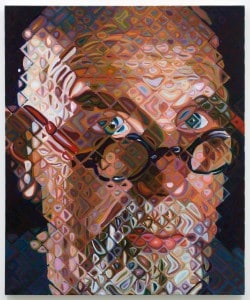
 New York Times’ Linda Yablonsky recently wrote this about the artist Chuck Close:
New York Times’ Linda Yablonsky recently wrote this about the artist Chuck Close:
“Close, who is 73, has been bound to a motorized wheelchair since 1988, when a spinal artery collapse caused near-total paralysis. That didn’t dampen his enthusiasm for either making art or collecting it, and other things as well …”
Wheelchair bound since 1988? “WTF? Somebody cut the man loose!” tweeted disability arts guru Lawrence Carter Long.
“I’m thinking that must be darn uncomfortable,” snarked author Simi Linton via Facebook. “And then [they] tell us that his condition didn’t ‘dampen his enthusiasm’ for all sorts of things.”
What does Close think about how the media portrays him? Here’s what he told our reporter, Laura Kaminker, back in December 1998:
LK: Many stories about you still focus on the “overcoming tragedy” angle.
CC: I’m not interested in that, it’s boring as hell. I had a long, successful career as an artist, long before anything happened to me. I think the only thing that’s interesting is that I got back to work, and is the work any good? I completely reject the notion that I’m any kind of a hero. I’ve just been very lucky.
First of all, I’m lucky I already was somebody. There are so many kids in rehab hospitals, because of diving accidents or motorcycle accidents or being shot. They’re so young, they don’t have anything to return to.
I was also lucky that I was self-employed; I didn’t have to convince an employer that I was capable of getting back to work, I only had to convince myself.
There are two other ways in which I am very lucky. One is that I am by nature an optimistic person, for which I can take no credit; that’s just who I am. Other people are by nature pessimistic, for which they should not be blamed; that’s just who they are. I think my optimism helped me get back to work.
But the last reason I reject the idea that I am any kind of hero is that I could afford to get back to work. I made a lot of money with my art, so I could build a wheelchair-accessible studio and hire assistants. I have excellent medical insurance, for which I pay an arm and a leg.
Even so, I have about $50,000 a year in unreimbursed medical expenses. If I didn’t make that $50,000, plus enough to live on, I’d have to go on Medicaid and become a ward of the state. So another artist, equally committed, equally determined to return to painting, but without the income, might not have been able to.
LK: I appreciate your awareness of luck. There’s so much of that, “If you want it badly enough and you try hard enough, you can do anything.”
CC: That’s a blame-the-victim mentality. In rehab I saw people with the greatest attitudes who struggled every day, worked so hard in PT, and never got one iota better. Then there’d be somebody else with the worst attitude in the world — lazy, nasty, whiny, wouldn’t work hard — and they got better and walked out. To suggest that if somebody only had a different attitude they’d get better is just this side of criminal.
Support New MobilityWait! Before you wander off to other parts of the internet, please consider supporting New Mobility. For more than three decades, New Mobility has published groundbreaking content for active wheelchair users. We share practical advice from wheelchair users across the country, review life-changing technology and demand equity in healthcare, travel and all facets of life. But none of this is cheap, easy or profitable. Your support helps us give wheelchair users the resources to build a fulfilling life. |


Recent Comments
Bill on LapStacker Relaunches Wheelchair Carrying System
Phillip Gossett on Functional Fitness: How To Make Your Transfers Easier
Kevin Hoy on TiLite Releases Its First Carbon Fiber Wheelchair